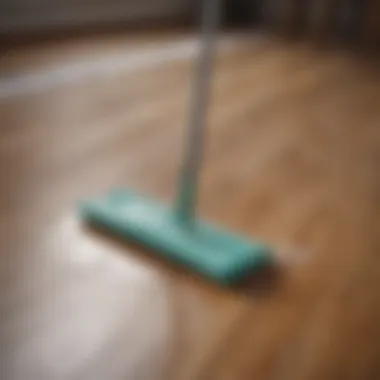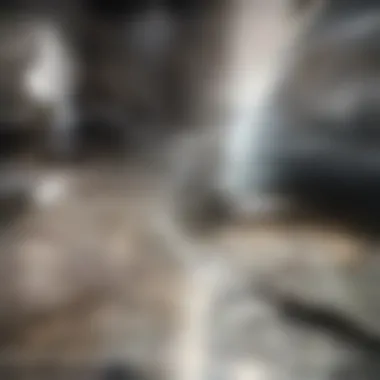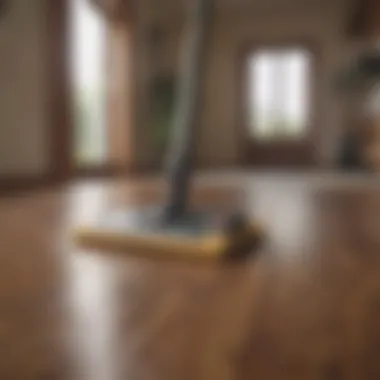Using Wet Swiffer on Laminate Floors: A Complete Guide


Intro
Maintaining the aesthetic and durability of laminate floors requires careful consideration of the cleaning methods used. One popular choice among homeowners is the wet Swiffer. However, questions often arise about the compatibility of wet cleaning products with laminate surfaces. Given the material's sensitivity to moisture, it is critical to understand proper technique and product application. This guide offers insights into effective cleaning practices, especially focusing on the wet Swiffer approach.
Home Design Inspiration
Importance of Clean Floors in Home Design
A clean and well-maintained floor can significantly enhance the overall appearance of a living space. Laminate floors, known for their affordability and stylish finish, contribute to a home's aesthetic appeal. As they can mimic the look of hardwood or stone, their cleanliness plays a vital role in highlighting the design elements of a room.
Architectural Styles and Floor Choices
When considering interior design, it is essential to match architectural style with appropriate flooring options. Laminate offers versatility across various styles:
- Modern: Pairing clean, sleek lines with light-colored laminate can create a spacious feel.
- Traditional: Dark wood laminate can add warmth and coziness to classic settings.
- Industrial: A rustic laminate finish aligns well with exposed materials and vivid colors.
This understanding of style allows homeowners to choose cleaning methods that not only maintain but also enhance their flooring.
Innovative Decor Trends
Current decorating trends emphasize simplicity and sustainability. This has led to a rise in versatile flooring choices such as laminate. Keeping these floors clean, particularly with tools like the wet Swiffer, aligns with these trends, making cleaning efficient and environmentally friendly. Moreover, homeowners can engage with innovative designs and products that support their cleaning routines while maintaining elegance at home.
End
To sum up, this guide will unravel the intricacies of using a wet Swiffer on laminate floors. It will provide practical tips on ensuring a sparkly surface while discussing the maintenance necessary to preserve the laminate's integrity. A well-informed cleaning approach contributes significantly to both the immediate appearance of laminate floors and their long-term durability.
Preface to Laminate Flooring
Laminate flooring has gained significant popularity in recent years. This kind of flooring offers a unique blend of style, durability, and affordability. Understanding laminate flooring is essential for homeowners and design enthusiasts who seek to maintain its aesthetic and functional qualities. In considering cleaning methods, like using a wet Swiffer, knowing the characteristics of laminate surfaces is key.
Understanding Laminate Composition
Laminate flooring consists primarily of multiple layers. The base layer provides stability. Above that, a core layer usually made of high-density fiberboard adds durability. The surface layer includes a photographic image of wood or stone, topped with a transparent overlay that protects against scratches and stains. Together, these layers create a product that mimics natural wood or stone while being resistant to wear and tear. This composition makes laminate an appealing choice for many.
Common Uses and Installation Areas
Laminate flooring is versatile and widely utilized in various environments. It is a common choice in residential settings, especially in living rooms, bedrooms, and dining areas. The ease of installation contributes to its popularity. Laminate can also be seen in commercial spaces like retail stores and offices, where appearance and maintenance flexibility are key. When chosen properly, laminate enhances the overall design while being an econimical option that withstands heavy foot traffic.
Cleaning Considerations for Laminate Floors
When it comes to laminate flooring, cleaning involves more than just a simple sweep or vacuum. Understanding the specific considerations for cleaning is essential for maintaining both the appearance and longevity of the floor. Laminate floors are popular for their aesthetic appeal and resilience, but they also require careful handling during cleaning to avoid damage.
The primary consideration with laminate flooring is the material's sensitivity to moisture. Excessive water can seep into seams and joints, leading to warping or swelling over time. Hence, the question of how to effectively clean laminate floors without compromising their integrity is paramount. On the other hand, regular and proper cleaning is necessary to prevent dirt and grime build-up, which can lead to dullness and wear. Understanding the balance between moisture levels and cleaning methods is key to preserving the beauty of laminate floors.


Impact of Moisture on Laminate
Moisture is a double-edged sword when it comes to laminate flooring. While it is necessary to remove stains and dirt, too much moisture can cause significant harm. Laminate flooring is designed to be water-resistant rather than waterproof. This means that quick spills can be wiped up without issue, but prolonged contact with water is detrimental.
The wood composite material used in laminate can absorb excess moisture, leading to expansion. If the seams of the planks absorb water, it may lead to delamination and structural failure. Consequently, a wet Swiffer, while convenient, must be used with caution to prevent over-saturation of the floor's surface. It is crucial to ensure that the cleaning tool does not leave an excessive amount of water behind.
Recommended Cleaning Methods
To effectively clean laminate floors, one should consider the following methods:
- Dry Sweeping or Vacuuming: Start with a dry mop or vacuum to remove debris. This helps in avoiding scratches that can occur from dirt particles.
- Damp Cleaning: Instead of soaking the floor, using a damp Swiffer is often advisable. This implies minimal water is used. It's effective against stubborn stains without risking damage.
- pH-neutral Cleaners: When using cleaning solutions, opt for those that are specifically formulated for laminate. Vinegar mixed with water can also be a safe alternative. Avoid harsh chemicals and excessive acidity which can degrade the finish.
"Using a dry mop periodically helps maintain the laminate's look and reduce the buildup of dirt, which makes deeper cleaning easier when necessary."
These recommendations underscore the importance of both protection and cleaning for laminate flooring. By adopting these practices, homeowners can enjoy the benefits of their laminate floors without experiencing degradation over time.
Evaluating the Wet Swiffer as a Cleaning Tool
Evaluating the Wet Swiffer as a cleaning tool is fundamental to understanding how to maintain laminate flooring effectively. Laminate floors require gentle yet effective cleaning solutions to preserve their finish and structural integrity. In this section, we will explore the design and features of the Wet Swiffer, followed by an analysis of its chemical solutions focusing on both efficacy and safety.
Design and Features of Wet Swiffer
Wet Swiffer is designed with versatility and ease of use in mind. Its lightweight structure means it is easy to maneuver in various areas of the home. The cleaning pads attach securely to the base of the device, ensuring they do not come loose during use. This feature is particularly important for thorough cleaning, as it allows consistent contact with the floor surface.
Additionally, the Wet Swiffer includes a built-in sprayer that allows homeowners to distribute a cleaning solution evenly across the floor. This design minimizes puddles, which can be detrimental to laminate. The handle is adjustable, providing comfort during use, which can be helpful when cleaning larger areas.
Chemical Solutions: Efficacy and Safety
The effectiveness of the Wet Swiffer largely depends on the cleaning solutions used. Most Wet Swiffer products are designed to tackle dirt and grime while being safe for laminate surfaces. However, homeowners should be cautious regarding the specific formulations. Some cleaning liquids may contain harsh chemicals that could damage laminate finishes over time.
It is advisable to read product labels carefully, ensuring that the chosen solution is compatible with laminate. Generally, solutions that are labeled as safe for hardwood or laminate floors can be used with Wet Swiffer. Their efficacy tends to be favorable, dealing well with everyday messes without excessive scrubbing.
"Using the correct cleaning solution with Wet Swiffer can help maintain the beauty and lifespan of your laminate floors."
When reviewing safety, it's essential to consider any allergic reactions or sensitivities. Opting for biodegradable and eco-friendly options can provide peace of mind. In summary, evaluating the Wet Swiffer combines assessing its physical design for user-friendliness and the chemical solutions for cleaning efficacy and safety. This understanding is vital for making informed cleaning choices that protect laminate floors.
Step-by-Step Guide to Using Wet Swiffer on Laminate Floors
Using a Wet Swiffer on laminate floors requires careful attention to detail. The right approach can ensure effective cleaning while preserving the floor's quality. This section outlines a systematic process that makes cleaning efficient. It highlights essential steps and provides insights on considerations to keep in mind for optimal results.
Preparation of the Area
Before applying the Wet Swiffer, it is vital to prepare the cleaning area. Start by removing all furniture and obstacles from the floor. This clears the space for better access and ensures a thorough cleaning. Take a moment to identify stubborn spots or stains.
Next, sweep or vacuum the floor to pick up any loose debris. This step is crucial; failing to do so may scratch the laminate surface during the wet cleaning process. If necessary, pay extra attention to corners and under appliances where dust hides. Clear surfaces lead to more effective cleaning, enhancing the outcome.


Applying the Wet Swiffer
Now that the area is prepared, it’s time to use the Wet Swiffer. First, check that the Swiffer is correctly assembled. Attach a cleaning pad suitable for laminate floors. Next, dampen the cleaning pad with the appropriate cleaning solution. The solution should be safe for laminate surfaces to avoid any damage.
Once the Swiffer is ready, glide it across the laminate floor in a systematic pattern. Going with the grain of the laminate can help remove the dirt effectively without causing streaks. Make sure to apply even pressure; if you press too hard, it may cause damage, while too light may not provide a thorough clean. Use slow, deliberate motions to ensure every part of the floor receives attention.
Finishing Touches and Drying
After you have finished swiffering the entire area, it’s important to let the floor dry properly. This helps prevent any moisture damage to the laminate. Allowing the surface to air dry is the best option. If moisture remains, blot it gently with a dry microfiber cloth to absorb excess liquid.
Finally, at this stage, replaced furniture can be cautiously moved back. Ensure that any pads or felt feet are under the furniture to prevent scratching. Taking these finishing touches into account amplifies the effectiveness of the wet cleaning process and maintains the elegance of your laminate flooring.
Maintenance Tips for Laminate Floors
Maintaining laminate floors requires regular attention to keep them looking fresh and extend their lifespan. This section discusses essential maintenance tips, enabling homeowners to take proactive measures in preserving their investment. Knowing how to care for these floors helps avoid common pitfalls related to moisture and scratches. It ensures both aesthetic appeal and durability, which is crucial in high-traffic areas of the home.
Daily Cleaning Practices
Daily cleaning practices for laminate floors should focus on minimizing dirt and debris accumulation. Dust and dirt can scratch the surface over time. Therefore, these simple steps can make a substantial difference:
- Use a soft broom or microfiber dust mop to sweep daily.
- Swap out traditional mops for dry mops. They effectively pick up dust without moisture.
- Avoid using a vacuum cleaner with a beater bar; it can cause scratches.
- If needed, dampen the mop slightly with water, ensuring it’s not soaking wet.
It is essential to clean up spills immediately using a soft cloth. This helps prevent moisture damage or staining. For general maintenance, refrain from using harsh chemicals, as they may strip the laminate of its finish.
Periodic Deep Cleaning Strategies
While daily cleaning is vital, periodic deep cleaning helps maintain the floors’ integrity further. Strategies for deep cleaning laminate include:
- Choosing the Right Cleaner: Use a cleaner specifically designed for laminate flooring. Home-inspected formulas often work best without risking damage.
- Dilution is Key: Always dilute the cleaner according to the manufacturer’s instructions. Excess cleaner can leave residue which attracts dirt.
- Soft Cloths or Mops: Utilize a soft cloth or mop to apply the cleaner. Avoid scrubbing, as it can lead to scratches on the surface.
- Rinsing: If using a damp mop method, ensure to rinse it frequently in clean water. This minimizes cleaner build-up.
- Seasonal Reviews: Consider a thorough inspection of your laminate floors every six months to check for any potential damages or maintenance needs.
Regular maintenance is not just about aesthetic appeal; it is critical for prolonging the life of the laminate flooring.
Remember, preventive measures today lead to less work—and more beauty—tomorrow.
By implementing both daily cleaning practices and periodic deep cleaning strategies, homeowners can enjoy attractive and lasting laminate floors.
Common Misconceptions about Wet Cleaning Laminate
Cleaning laminate floors with a wet Swiffer can provoke various opinions. Many individuals hold common misconceptions about the suitability of wet cleaning methods for laminate surfaces. Highlighting these misconceptions is key to understanding how to properly maintain these types of floors.
Wet cleaning inappropriately performed can lead to damage. However, when done correctly, it does not compromise the integrity of laminate flooring. The discussion below clarifies pressing myths and helps homeowners make informed decisions.
Busting Myths: Wet vs. Dry Cleaning
One notable misconception is that wet cleaning methods are always harmful to laminate floors. While laminate is not entirely permeable, it can withstand some moisture. Wet cleaning may indeed pose risks, but using a wet Swiffer with care mitigates these concerns effectively. Dry cleaning, which primarily relies on dusting and sweeping techniques, tends to remove surface debris but leaves behind other substances such as spills or stains.


Using a Swiffer incorporates both wet and dry techniques. The wet pads clean effectively by adding moisture without being overly saturated. Therefore, the balance between wet and dry methods is essential. Homeowners can achieve a clean floor without risking damage if they manage moisture correctly.
Analyzing Long-Term Effects on Laminate Integrity
It's critical to consider potential long-term effects of repetitive wet cleaning on laminate floors. Some might worry about warping or swelling due to excessive moisture. It is true that prolonged exposure to water can lead to such issues; however, moderate use of a wet Swiffer should not lead to deterioration.
Laminate flooring is designed to resist moisture to a certain degree. Still, it is crucial to avoid excess water. Key considerations include:
- Frequency of wet cleaning: Limit wet cleaning to avoid possible damage. A monthly schedule is often advisable.
- Quality of cleaning pads: Using high-quality, specially designed Swiffer pads prevent excessive moisture on floor surfaces.
- Immediate response to spills: Quick action to clean up spills can prevent long-term issues that arise from standing water.
Environmental Considerations
When discussing the use of a wet Swiffer on laminate floors, it is essential to consider the environmental impact of cleaning products and practices pursued in modern homes. Cleaning solutions, including the wet Swiffer, often rely on various chemicals, which can have consequences for both human health and the planet. Thus, understanding these aspects helps individuals make informed cleaning choices that benefit their surroundings.
Sustainability of Cleaning Products
The sustainability of cleaning products pertains to their life cycle, from production to disposal. Many conventional cleaning agents are made from non-renewable resources and contain harmful substances that can contaminate waterways and soil. As environmentally aware consumers, one should evaluate the ingredients in cleaning products. Ingredients that are biodegradable, non-toxic, or derived from renewable resources contribute to sustainability.
Consider looking for products labeled with certifications such as Green Seal or EcoLogo, which indicate adherence to eco-friendly standards. Furthermore, developing a habit of purchasing in bulk or using concentrated formulas can minimize packaging waste.
Eco-Friendly Alternatives to Wet Swiffer
While the Wet Swiffer is popular, there are several eco-friendly alternatives worth considering:
- Reusable Cloths: Instead of disposable pads, consider using washable microfiber cloths. They are effective at trapping dust and dirt without contributing to landfill waste.
- Natural Cleaning Solutions: Homemade solutions, using ingredients like vinegar or baking soda, can often replace commercial cleaners. These not only reduce chemical exposure but also minimize environmental impact.
- Refillable Systems: Some brands offer refillable cleaning systems that reduce single-use plastics. These systems often allow users to mix their own solutions for cleaning, promoting better waste management.
Ultimately, choosing products and methods that align with sustainable practices is crucial for preserving the integrity of the environment. By prioritizing eco-friendly cleaning options, users can maintain their laminate floors without compromising their commitment to a healthier planet.
"Sustainable cleaning choices result in healthier homes and a safer environment for future generations."
In summary, understanding the sustainability of cleaning products and exploring eco-friendly alternatives can enhance the overall cleaning experience while minimizing adverse effects on the environment. Embracing these practices will not only help maintain the quality of your laminate flooring but also promote a cleaner, greener lifestyle.
Epilogue
In review, the use of Wet Swiffer on laminate floors offers an effective cleaning solution, yet it demands understanding and caution. It is crucial to weigh the benefits and drawbacks thoroughly. Utilizing a Wet Swiffer can enhance the longevity and look of your laminate surfaces, provided that best practices are adhered to. This guide emphasizes the importance of adapting cleaning techniques to specific flooring types, particularly laminate.
Understanding the material’s composition will inform choices around moisture and cleaning agents. While the Wet Swiffer design allows for convenience and ease, one must not overlook the potential risks associated with excess moisture on laminate surfaces.
Final Thoughts on Wet Swiffer Use
The Wet Swiffer serves as a practical tool in the repertoire of cleaning options available for laminate flooring. With its user-friendly design, it delivers a level of convenience that aligns perfectly with the busy lifestyles many lead. However, it is essential to remain mindful of its limitations. Relying solely on this tool without following up with proper drying methods can lead to possible damage over time.
In practice, effective use requires balancing moisture application with drying, emphasizing the need for a delicate touch. Thus, when using the Wet Swiffer, it is wise to ensure the floor dries promptly to retain the integrity of the laminate surface. By combining this cleaning method with appropriate care measures, homeowners can maintain vibrant and durable flooring.
Reiterating Best Practices for Laminate Care
To ensure optimal maintenance of laminate floors, follow these best practices:
- Regular Dusting: Employ dry dust mops or the dry side of the Swiffer frequently to remove dirt and debris.
- Monitor Moisture: Limit the use of wet cleaning methods, ensuring that the floor is not saturated. A slightly damp cloth or mop is preferable.
- Choose Safe Cleaners: Be selective with the cleaning products used on laminate. Eco-friendly solutions are ideal as they minimize harsh chemical exposure.
- Immediate Cleanup of Spills: Address spills quickly to prevent water damage, which can compromise the laminate’s durability.
- Consider Area Rugs: Use rugs in high-traffic areas to help protect the laminate and reduce wear.
By integrating these practices into routine care, one can significantly enhance both the beauty and lifespan of laminate flooring. Awareness and thoughtful action serve as key factors in ensuring that your laminate surfaces remain appealing and resilient through time.







